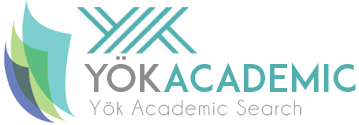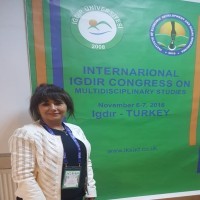Research Article
Issue Reviewers





 Web
Web



Yeni Türk Edebiyatı alanında 2020 yılında doktoramı almış bulunmaktayım. Hâlen daha bu alanda çalışmalar yapmaya devam etmekteyim.


Lisans Hacettepe Üniversitesi
Y. Lisans Türk Dili ve Edebiyatı Fırat Üniversitesi Sosyal Bilimler Enstitüsü (Nogay Türkçesi Grameri, Giriş-İnceleme-Metin-Sözlük)
Doktora Türk Dili ve Edebiyatı Fırat Üniversitesi Sosyal Bilimler Enstitüsü (Kırımçak Türkçesi Grameri Giriş-İnceleme-Metin-Sözlük)
Yrd. Doç. Dr. Türk Dili ve Edebiyatı Kafkas Üniversitesi Fen Edebiyat Fakültesi 2006-2018
Doç. Dr. Türk Dili ve Edebiyatı Iğdır Üniversitesi Fen Edebiyat Fakültesi 2018-Halen

Çok sayıda makalesi, tebliği ve ansiklopedi maddesi yayımlanan S. Bekki, üç yıl (Güz/2012- Güz/2014) süreyle Türklük Bilimi Araştırmaları (TÜBAR) Dergisinin Yazı İşleri Müdürlüğünü yürüttü.
14 Mart 2017’de profesörlüğe yükseltilen Bekki, hâlihazırda Kırşehir Ahi Evran Üniversitesi Fen-Edebiyat Fakültesi Türk Dili ve Edebiyatı Bölüm başkanlığını yürütmekte olup İLESAM üyesi, evli ve üç çocuk babasıdır.
Prof. Dr. Salahaddin Bekki’nin on biri telif ikisi editörlük olmak üzere yayımlanan on üç kitabı bulunmaktadır.
Aim & Scope
Journal of TAM Academy (TAMDE) was established by the Center for Social Research (Turkish abbreviation is TAM). to make scientific contributions to many fields within the social sciences at national and international level.
TAMDE is a peer-reviewed journal and mainly evaluates the studies in the following fields;
- Open and Distance Learning
- Informatics
- Language and Literature
- Education
- Economy
- Philosophy
- Fine Arts
- Lifelong Learning
- Law
- Theology
- Communication
- Psychology
- Politics
- Social Psychology
- Sociology
- History
- Tourism
- International Relations
Author Guidelines
Article Structure
- Journal of TAM Academy accepts articles in Turkish and English. Regardless of Turkish or English, the abstract and keywords in both languages must be included in the articles.
- For articles written in Turkish, the Extended Abstract in English should be added after the Abstract and Keywords section.
The English Extended Abstract should include the subject, purpose, research questions/hypotheses, the method used and the results achieved, and should not exceed two pages.
The order of articles in Turkish should be as follows:
- Turkish Article Title
- Essence
- Keywords (5 pcs)
- English Article Title
- Abstract
- Keywords
- Extended Summary in English
…
- If the article is written in English, the English abstract and keywords should be included under the English title. Then, under the Turkish title, Turkish abstract and keywords should be included. English Extended Abstracts are not required for articles written in English.
The order of articles in Turkish should be as follows:
- English Article Title
- Abstract
- Keywords (5 pieces)
- Turkish Article Title
- Essence
- Keywords (5 pcs)
- Introduction
...
- You can use our writing template at https://tamde.org/index.php/tamde/libraryFiles/downloadPublic/3 when submitting your articles. In order to make the editorial process faster, it is important that you submit your articles in accordance with our writing template. Journal of TAM Academy has the right to directly reject the articles that are not submitted in accordance with the spelling template.
- The article should be in A4 size. Page margins should be 2.5 cm for Top, Bottom, Right and Left, and the page should be positioned vertically. However, large tables, graphics, pictures, etc. only the page containing the content can be positioned horizontally.
- If an explanation about the article needs to be added, footnote should be given as number 1.
Example:

- Author information should be included after the title of the article. Author names should be added just below the title, separated by commas. Footnotes should be given to each author, starting with 1 if there is no article description, and 2 if there is an article description. In the footnote section, the author's title, institution, department, e-mail and ORCID information should be included, respectively.
(Authors who send their article to our journal for evaluation should not apply the 8th item at the first stage. In accordance with the double-blind refereeing system we have adopted, author information should not be included in the article at the first stage. If your article is found suitable for publication after the refereeing process, your article will be sent to you again by the editor to make the necessary arrangements.)
- The abstract should not be less than 100 words, and not more than 300 words. In the abstract part, the aim, method and the result of the study should be explained briefly. References should not be made in the abstract.
- Under the abstract, there should be 5 keywords as in the spelling template. Keywords should be capital letters.
- Titles such as Article Title, Abstract, Introduction, Content Titles, Conclusion and Bibliography should be 12 in font size and Calibri (Body) font. Only the initials of the titles should be written in capital letters.
- Main, intermediate and sub-titles should be used in the article in order to determine the structure of the article and to provide a regular information transfer in the main text. If necessary, the headings should be numbered after the Introduction.
Introduction
- Main Title
1.1. Subtitle
- Main Title
2.1. Subtitle
- Line spacing in the entire document should be 1.15 cm.
- Paragraph spacing should be Left, Right, and 0nk Before and 8nk After.
- All texts except the title should be in Calibri (Body) font and font size 11.
- While titling, the heading degree should be selected from the style menu of Word and the font specified in the previous article should be applied.
Figures, Tables and Images
- Figures and visuals should be numbered starting from one and the explanation should be below the content.
- Tables should also be numbered starting from one. However, unlike the figures and visuals, the explanation should be above the table.
- The paragraph spacing of the tables should be 0nk in Before, After, Left and Right, and the font size should be 10 points. Table height should be as narrow as possible according to the content.
- Table, figure and visual explanations should be in 10 points.
Bibliography Style
- Journal of TAM Academy accepts articles prepared according to the latest version (7th Edition) of the APA citation system.
- Journal of TAM Academy recommends using reference management systems such as Mendeley, Zotero, Endnote for citation and bibliography. Word's own bibliography management system is compatible with Turkish. However, when APA style is used in bibliography management systems such as Mendeley, Zotero, and Endnote, adaptation problems with Turkish can be experienced. To solve this problem, you need to download the Turkish-adapted style file of APA from https://github.com/citation-style-language/styles/blob/master/apa-tr.csl and add it from the style settings menu of the relevant program.
- In in-text references, pages, paragraphs, etc. information should be included. Example: It should be (Yılmaz & Köse, 2012, p. 217), not (Yılmaz & Köse, 2012: 217).
- The most commonly used resource types in APA 7th Edition are:
Single Author Book
References: Yılmaz H. (2016). Becoming Turkish: Nationalist Reforms and Cultural Negotiations in Early Republican Turkey 1923-1945. Syracuse University Press
In-text: (Yılmaz, 2016, p. 45).
Book with Two Authors
References: Yılmaz, M., & Köse, Aynur. (2012). Seçimler ve Değerler. Serander Yayınları
In-text: (Yılmaz & Köse, 2018, p. 94)
Book with Three Authors
References: Binark, M., Bayraktutan, G., & Durna, T. (2020). İletişim Hakkı ve Yeni Medya Tehditler ve Olanaklar. Uğur Mumcu Vakfı Yayınları.
In-text: (Binark vd., 2020, p. 16)
Book with More than Three Authors
References: Turban, E., Outland, J., King, D., Lee, J. K., Liang, T.-P., & Turban, D. C. (2018). Electronic Commerce 2018: A Managerial and Social Networks Perspective. Springer International Publishing.
In-text: (Turban vd., 2018, p. 314)
Translation Books
References: Goodfellow, I., Bengio, Y., & Courville, A. (2018). Derin Öğrenme (Fatoş Yarman Vural, R. G. Cinbiş, & S. Kalkan, Çev.). Buzdağı Yayınevi.
In-text: (Goodfellow vd., 2018, p. 59)
Compilation Books
References: Mutlu, E. (Der.). (2010). Kitle İletişim Kuramları. Ütopya Yayınevi.
In-text: (Mutlu, 2010, p. 66)
Journal Articles
References: Yılmaz, M. ve Karakaş, O. (2019). ANALYSIS OF 23 JUNE 2019 ISTANBUL METROPOLITAN MUNICIPALITY ELECTION IN TERMS OF POLITICAL VALUES. AJIT-e: Online Academic Journal of Information Technology, 10(38), 35-52. doi:10.5824/1309-1581.2019.3.002.x
In-text: (Yılmaz & Karakaş, 2020, p. 76)
Web Pages
References: Akan, Y. (2018, June 9). Yeni Medya Nedir ve Ne İş Yapar? | Pazarlama Türkiye. https://pazarlamaturkiye.com/gun-gectikce-populerlesen-yeni-medya-nedir-ve-ne-is-yapar/
In-text: (Akan, 2018, par. 2) – (Par., paragrafın kısaltmasıdır.)
Ethical Principles and Publication Policy
TAM Akademi Dergisi uses the name Journal of TAM Academy in English and TAMDE as an abbreviation. In the following sections, the abbreviation TAMDE will be used, which replaces the name of Journal of TAM Academy.
GENERAL PRINCIPLES
- TAMDE is an international peer-reviewed journal published by the Center for Social Studies.
- TAMDE publishes two issues a year, in May and November. In TAMDE, which is only published electronically, the entire process is carried out on tamde.org.
- At TAMDE, the entire process is carried out via tamde.org.
- Submission of articles to TAMDE via tamde.org is always welcome. However, due to the intensity of the editorial board and/or the long duration of referee evaluations, the evaluation process of the articles can take up to 3 months.
- Studies whose evaluation process has been completed are selected by the editorial board to be published for the appropriate issue.
- TAMDE undertakes to implement the publication ethics at the highest standards and to follow the guide prepared by the Committee on Publication Ethics (COPE: Committee on Publication Ethics).
- All legal and scientific responsibilities regarding the contents of the articles published in TAMDE belong to the author(s).
- Journal of TAM Academy defines Open Access in the light of the principles defined by the Budapest Open Access Initiative (BOAI) and adopts the BOAI's definition of open access below. In this context, TAMDE does not demand any monetary or moral fee from the authors for the processing and printing of the articles during the application process.
- After the evaluation process in TAMDE, each article published is assigned a DOI (Digital Object Identification System) number.
- For articles accepted for publication, a “Certificate of Acceptance for Publication” signed by the editor is sent upon the request of the author.
- TAMDE uses the information such as name, title and e-mail addresses shared during the membership to tamde.org only for the stated purposes of this journal; does not use it for any other purpose or make it available to other people. However, events such as symposiums, congresses, conferences or conversations to be organized by the Social Research Center are sent to the e-mail addresses shared during membership. If you do not want to be informed about the events organized by the Center for Social Studies, you can contact editor@tamde.org.
- “Copyright Transfer Form” must be filled and signed by all authors and uploaded to the journal system together with the article. With the signing of the form, TAMDE owns all the publishing rights of the articles published at the end of the evaluation process.
- Articles submitted to TAMDE must not have been previously published in another publication or accepted for publication. Otherwise, all responsibility belongs to the author(s). The relevant article will be withdrawn by the editorial board.
- TAMDE accepts studies derived from thesis, presentation or paper as well as research articles. However, it must meet the following conditions:
- If the work is derived from a paper; the title of the paper, the name, date and location of the event should be added to the article description.
- If the study is produced from postgraduate theses; the name of the thesis, the name of the advisor, the university and institute information and the completion date of the thesis should be stated in the footnote.
- The study was supported by the research institution or fund; the name of the supporting organization, the project number and the date of completion should be stated in the footnote.
ETHICAL PRINCIPLES
TAMDE has benefited from the guidelines and policies published by the Committee on Publication Ethics (COPE) while defining the ethical duties and responsibilities below.
Ethical Principles That Authors Must Follow
- TAMDE accepts the original studies of the author(s).
- The author(s) must cite the studies he has used, completely and accurately, using APA version 7.
- Persons who do not contribute to the content intellectually in the creation of the study should not be specified as authors.
- Situations and relationships that may constitute a conflict of interest, if any, of all studies submitted for publication should be disclosed. You can access our Conflict of Interest Policy here.
- Raw data regarding their articles can be requested from the author(s) within the framework of the evaluation processes, in such a case the author(s) is obliged to present the expected data and information to the editor and editorial board.
- The author(s) must have a document showing that they have the right to use the data used, the necessary permissions for the research/analysis, or the consent of the experimental subjects.
- In the event that the author(s) notices a mistake or an error in their published, early appearance or evaluation work, they are obliged to cooperate with the editor in informing, correcting or withdrawing the journal editor or publisher.
- Authors cannot have their study in the application process of more than one journal at the same time. Each application can be started following the completion of the previous application. A study published in another journal cannot be sent to TAMDE.
- Changing the author responsibilities of a study whose evaluation process has begun (such as adding an author, changing the order of authors, removing an author) cannot be proposed.
Ethical Principles That Editors Must Follow
Editors are responsible for every content published on TAMDE. In the context of this responsibility, editors must fulfill the following roles and responsibilities:
- Making efforts to meet the information needs of readers and writers,
- Ensuring that every article published in TAMDE is published in accordance with TAMDE publication policies and international standards,
- Ensuring the continuous development of the journal,
- Conducting processes to improve the quality of studies published in the journal,
- Supporting freedom of thought,
- Ensuring academic integrity,
- Continuing business processes without compromising intellectual property rights and ethical standards,
- Demonstrating openness and transparency in terms of publication on issues that require correction and clarification.
Editors’ Relationship with Readers
Editors should make decisions by considering the knowledge, skills and experience expectations of all readers, researchers and practitioners. It should be careful that the published studies contribute to the reader, researcher, practitioner and scientific literature and that they are original. In addition, editors are obliged to consider the feedback from readers, researchers and practitioners, and to provide explanatory and informative feedback.
Editors’ Relationship with Authors
The duties and responsibilities of the editors to the authors are as follows:
- Editors should make a positive or negative decision based on the importance, original value, validity, clarity of the narrative, and the purpose and scope of the journal.
- Studies that are in accordance with the scope of publication and writing rules should be evaluated by the referee.
- Editors should not ignore positive referee suggestions unless there are any problems with the study.
- Editors newly appointed to the work should not change the decisions made by the previous editor(s) unless there is a problem.
- Editors, "Double-Sided Blind Refereeing and Evaluation Process" must be operated and any problems that may arise in the defined processes should be resolved.
- Authors should be informed and returned in an explanatory and informative way.
Editors' Relationship with Reviewers
The duties and responsibilities of the editors towards the referees are as follows:
- The referees should be determined in accordance with the subject of the study.
- It is responsible for providing the information and guides that the referees will need during the evaluation phase.
- It has to consider whether there is a conflict of interest between the authors and the referees.
- Within the framework of the principle of Double Blind Arbitration, the identities of the referees should be kept confidential.
- Encourage reviewers to evaluate the work in an impartial, scientific and objective language.
- It should determine practices and policies that increase the performance of referees.
- Take the necessary steps to dynamically update the referee pool.
- It should prevent rude and unscientific evaluations.
- Take steps to ensure that the referee pool is broad.
Editors' Relationship with Editorial Board
Editors should inform the members of the editorial board about the editorial policies and keep them informed of the developments. In this context, the editorial board should advance the process in accordance with the journal's publication policies and guidelines. In addition, editors;
- Should ensure that the members of the editorial board evaluate the study impartially and independently.
- New editorial board members should be determined as contributing and suitable.
- The members of the editorial board should send studies suitable for their field of expertise for evaluation.
- must interact regularly with the editorial board.
- Regular meetings should be held with the editorial board for the development of publication policies and the journal.
Editors' Relationship with Journal Owner and Publisher
The relationship between the editors and the publisher is based on the principle of editorial independence. The journal owner, publisher and no other political or commercial factors should affect the editors' independent decision making.
Ethical Principles that editors must follow in the evaluation process
Editors should lead the evaluation process in accordance with the principle of "Double-Sided Blind Refereeing" in the journal's publication policies. In addition, the editors ensure that each work is completed in a fair, unbiased and timely evaluation process.
Editors' Protection of Personal Data
Editors are obliged to ensure the protection of personal data regarding the subjects or images included in the evaluated studies. It is responsible for refusing to work unless the explicit consent of the individuals used in the studies is documented. In addition, editors are responsible for protecting the individual data of authors, referees and readers.
Editors Request Ethics Committee Approval and Protect Intellectual Property Rights
Editors must request ethics committee approval for the following studies:
- All kinds of research conducted with qualitative or quantitative approaches that require data collection from the participants by using survey, interview, focus group work, observation, experiment, interview techniques,
- The use of humans and animals (including material/data) for experimental or other scientific purposes,
- Clinical studies on humans,
- Research on animals,
- Retrospective studies in accordance with the personal data protection law.
Editors also;
- Indicating that “Informed Consent Form” was received in case reports,
- Obtaining and specifying permission from the owners for the use of scales, questionnaires, photographs belonging to others,
- It is necessary to indicate that copyright regulations are complied with for the intellectual and artistic works used.
- Editors are responsible for refusing to work in the absence of permissions for research.
Editors' Action Against Possible Abuse
Editors are obliged to take precautions against possible abuses. It is among the responsibilities of the editor to share the relevant findings, as well as to conduct a rigorous and objective investigation regarding the identification and evaluation of complaints regarding this situation.
Ensuring the Integrity of Academic Publication by Editors
Editors should ensure that judgments containing errors, inconsistencies or misdirection in studies are promptly corrected.
Editors' Constructivism and Openness to Discussion
Editors;
- should take into account the persuasive criticisms of the studies published in the journal and display a constructive attitude towards these criticisms.
- should give the right to reply to the author(s) of the criticized study.
- should not ignore or exclude studies with negative results.
Editors' Attitude to Complaints
Editors are responsible for carefully examining and responding to complaints from authors, referees or readers in an enlightening and explanatory manner.
Editors' Attitude to Conflicts of Interest
Editors ensure that the publication process is completed independently and impartially, taking into account the conflicts of interest between the author(s), referees and other editors.
Ethical Responsibilities of Referees
The evaluation process at TAMDE is carried out with the principle of "Double-Sided Blind Arbitration". Reviewers cannot directly communicate with the authors, evaluations and comments are sent to the editor via the journal management system. In this process, reviewer comments on evaluation forms and full texts are forwarded to the author(s) through the editor. In this context, it is expected that the reviewers evaluating the study for TAMDE have the following ethical responsibilities:
- He should agree to evaluate only studies related to its field of expertise.
- Evaluation should be done with impartiality and confidentiality.
- If he thinks that he is facing a conflict of interest during the evaluation process, he should refuse to review the study and inform the journal editor.
- In accordance with the principle of confidentiality, they should destroy the studies they have examined after the evaluation process. They can only use the final versions of the studies they have reviewed after they are published.
- He should make the evaluation objectively only in relation to the content of the study. Nationality, gender, religious beliefs, political beliefs and commercial concerns should not be allowed to influence the evaluation.
- He should make the assessment in a constructive and courteous language. He shouldn’t make derogatory personal comments that include hostility, slander and insults.
- He should perform the study that he accepts to evaluate on time and with the above ethical responsibilities.
Ethical Responsibilities of the Publisher
TAMDE editors and editorial board act with the awareness of the following ethical responsibilities:
- Editors are responsible for all processes of the studies submitted to TAMDE. In this context, the decision makers are the editors, regardless of economic or political gains.
- It undertakes to create an independent editorial decision.
- TAMDE protects the property and copyright of every published article and undertakes to keep a record of every published copy.
- It is responsible for taking all kinds of scientific misconduct and plagiarism precautions regarding the editors.
If you encounter unethical behavior or content other than the ethical responsibilities mentioned above, please report it via e-mail to editor@tamde.org.
Price Policy
TAMDE is an open-access journal, and no article submission/process fees are requested from authors at any stage.
Indices
Our e-mail address for contact: editor@tamde.org
All articles in this journal are licensed under Attribution-NonCommercial-ShareAlike 4.0 International (CC BY-NC-SA 4.0).
Journal of TAM Academy is an open access journal. Readers can access all articles without registration and without paying.





